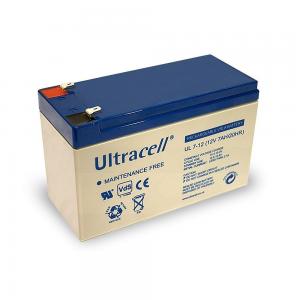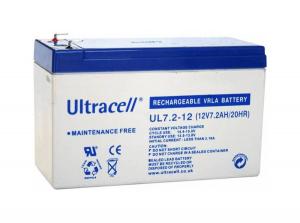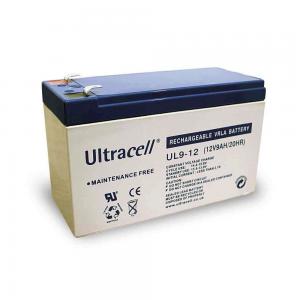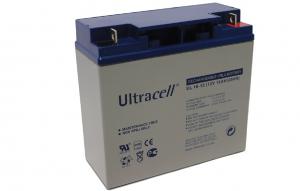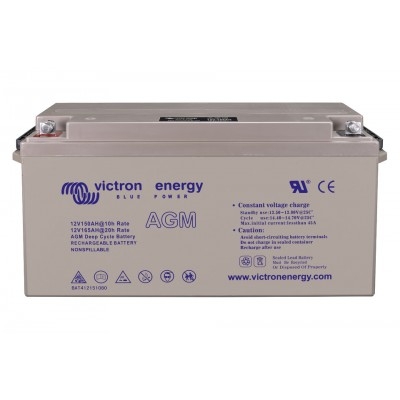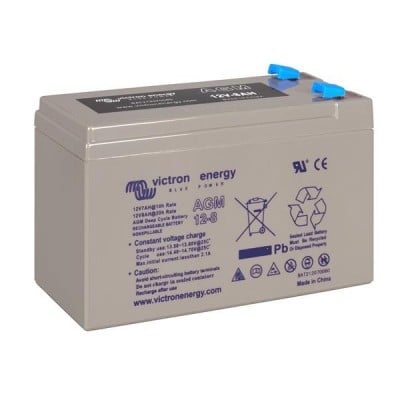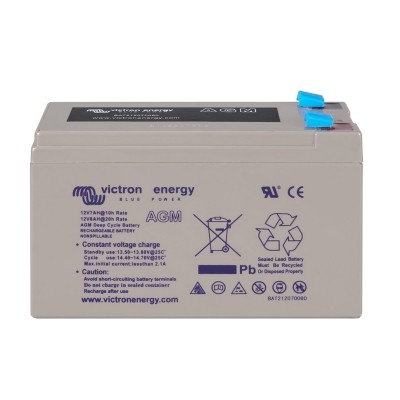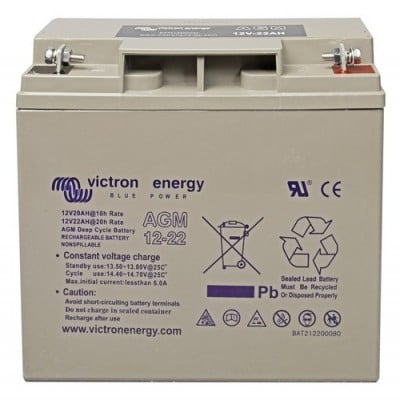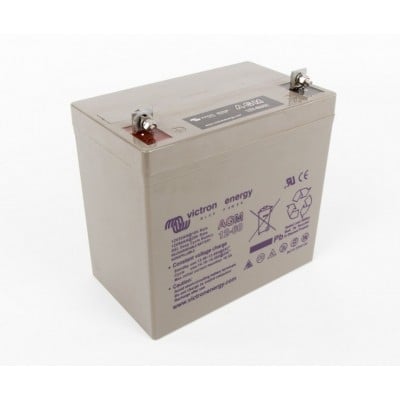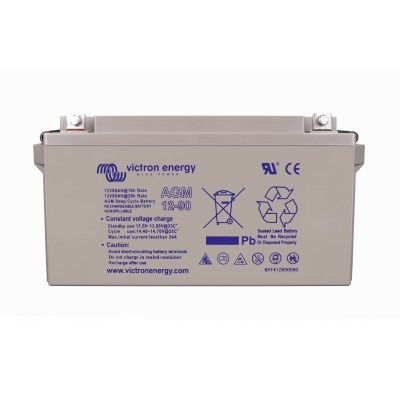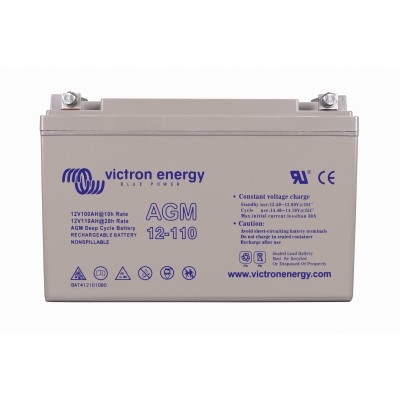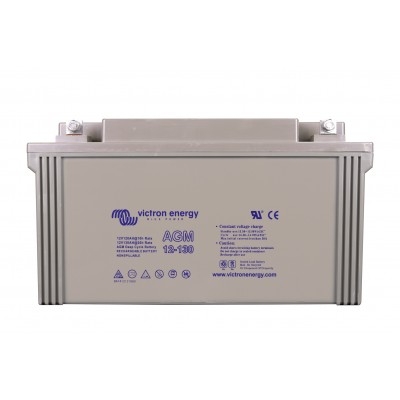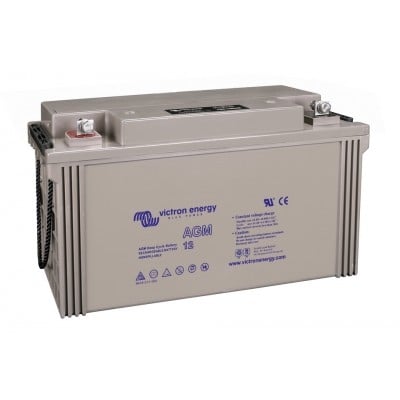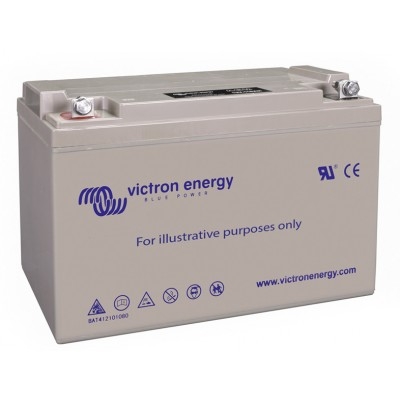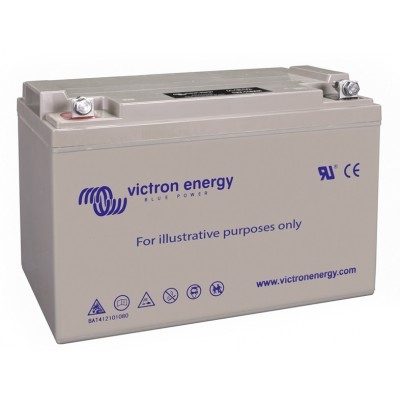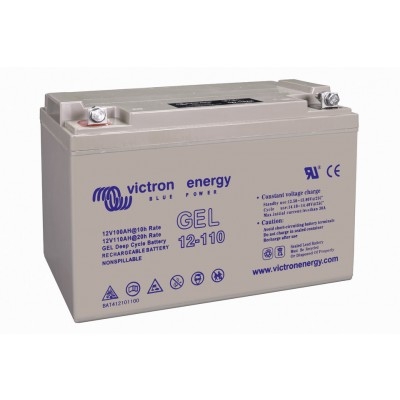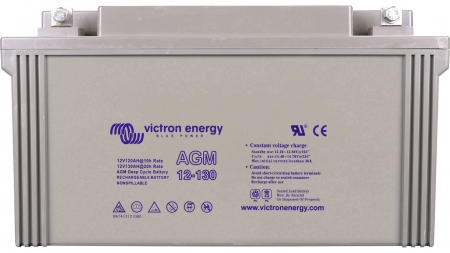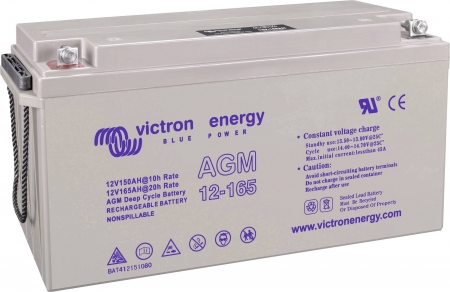Battery
Display: 1-24 from 79 products
- Brand: Ultracell
All Purpose
Emergency Light
Backup Power Supply
Aircraft Signal
Security Systems
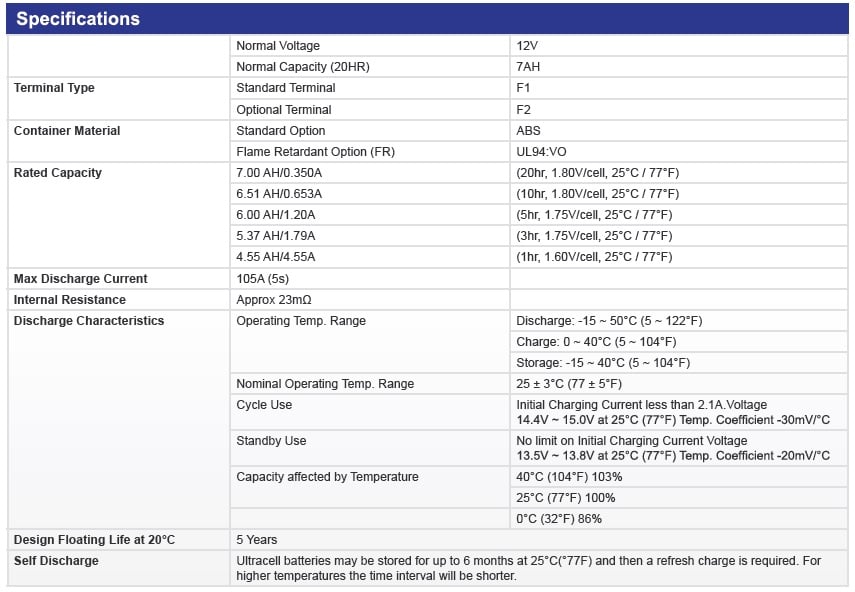

Length: 151 ± 2 mm (5.94 inches)
Width: 65 ± 2 mm (2.56 inches)
Container Height: 93.5 ± 2 mm (3.68 inches)
Total Height (with terminal): 99 ± 2 mm (3.90 inches)
Approx Weight: Approx 2.05kg (4.52lbs)
- Brand: Ultracell
All Purpose
Emergency Light
Backup Power Supply
Aircraft Signal
Security Systems
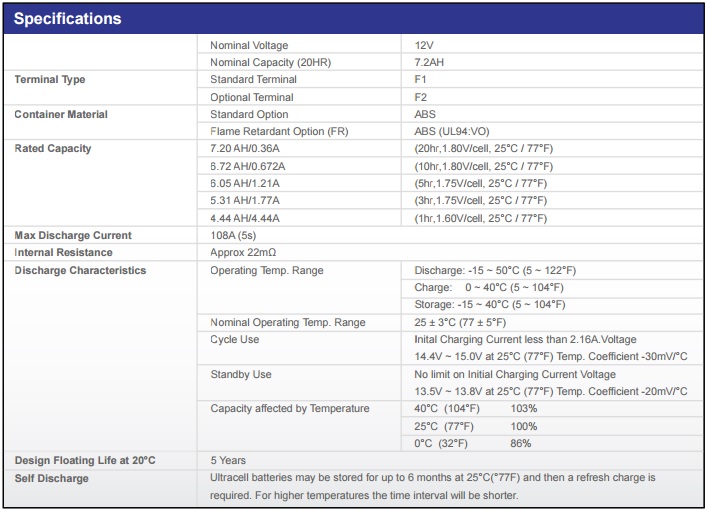

Length: 151 ± 2 mm (5.94 inches)
Width: 65 ± 2 mm (2.56 inches)
Container Height: 93.5 ± 2 mm (3.68 inches)
Total Height (with terminal): 99 ± 2 mm (3.90 inches)
Approx Weight: Approx 2.15kg (5.18lbs)
- Brand: Ultracell
All Purpose
Emergency Light
Backup Power Supply
Aircraft Signal
Security Systems
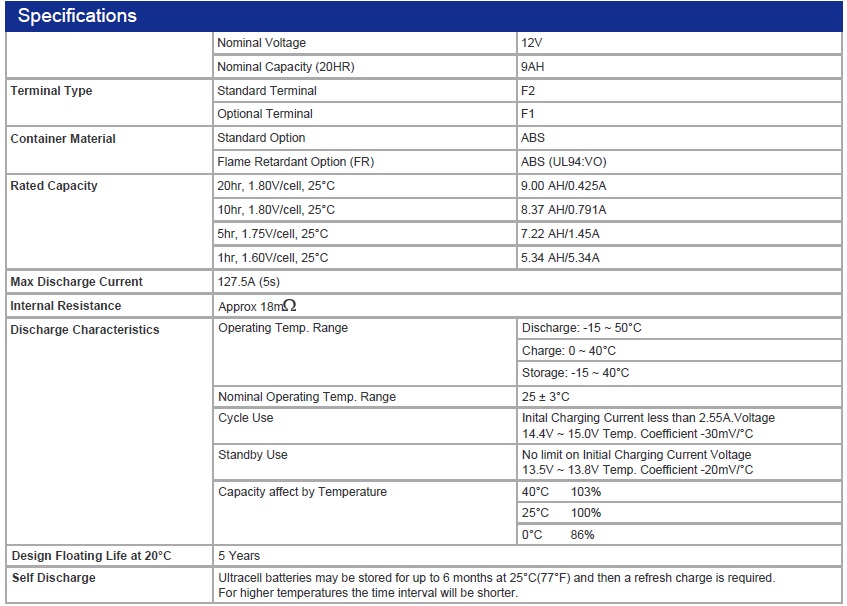
 Length: 151 ± 2 mm (5.94 inches)
Length: 151 ± 2 mm (5.94 inches)Width: 65 ± 2 mm (2.56 inches)
Container Height: 93.5 ± 2 mm (3.68 inches)
Total Height (with terminal): 99 ± 2 mm (3.90 inches)
Approx Weight: Approx 2.45Kg
- Brand: Ultracell
All Purpose
Emergency Light
Backup Power Supply
Aircraft Signal
Security Systems
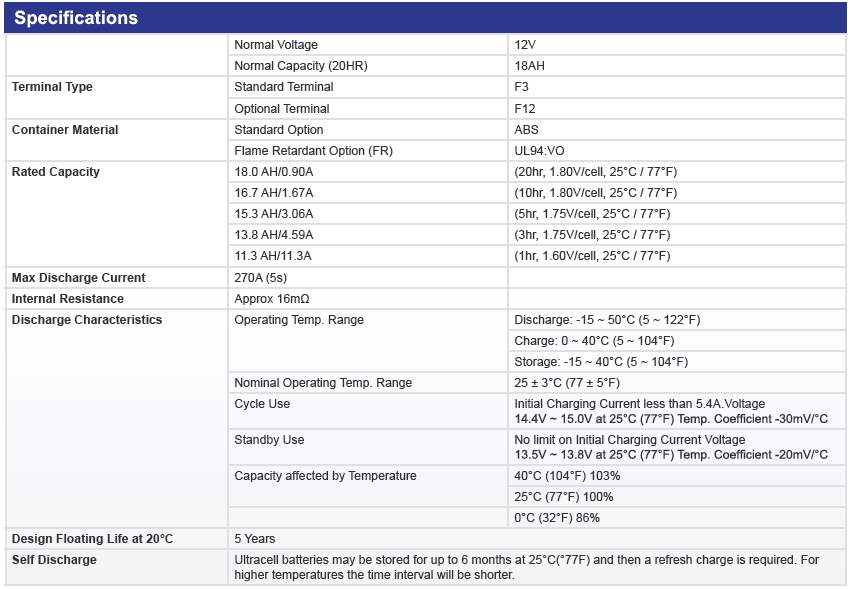
 Length: 181.5 ± 2 mm (7.14 inches)
Length: 181.5 ± 2 mm (7.14 inches)Width: 77 ± 2 mm (3.03 inches)
Container Height: 167.5 ± 2 mm (6.59 inches)
Total Height (with terminal): 167.5 ± 2 mm (6.59 inches)
Approx Weight: Approx 5.32kg (11.73lbs)
- Brand: Ultracell
All Purpose
Emergency Light
Backup Power Supply
Aircraft Signal
Security Systems
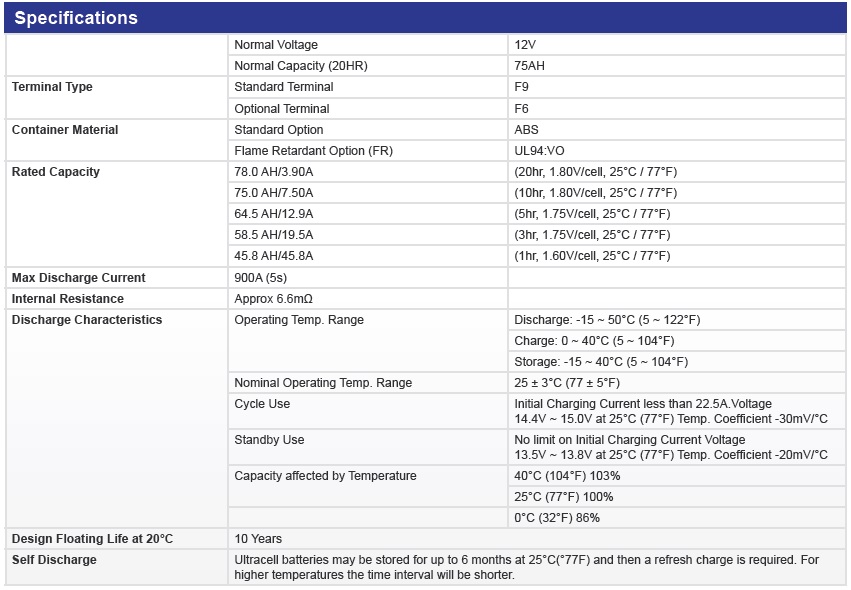 Length: 259 ± 2 mm
Length: 259 ± 2 mm Width: 168 ± 2 mm
Container Height: 208 ± 2 mm
Total Height (with terminal): 214 ± 2 mm
Approx Weight: Approx 22.3kg

- Brand: Victron Energy
The AGM range has very low internal resistance making them particularly suitable for high current discharge applications such as for inverters, thrusters and winches as well as engine starting. VRLA AGM: design life 7-10 years
VRLA technology
VRLA stands for Valve Regulated Lead Acid, which means the batteries are sealed. Gas will escape through the safety valves only in case of overcharging or cell failure. VRLA batteries are maintenance free for life.
Sealed (VRLA) AGM Batteries
AGM stands for Absorbent Glass Mat. In these batteries the electrolyte is absorbed into a glass-fibre mat between the plates by capillary action. As explained in our book ‘Energy Unlimited’, AGM batteries are more suitable for short-time delivery of very high currents (engine starting) than gel batteries.
Low Self-Discharge
Because of the use of lead calcium grids and high purity materials, Victron VRLA batteries can be stored during long periods of time without recharge. The rate of self-discharge is less than 2% per month at 20°C. The self-discharge doubles for every increase in temperature by 10°C. Victron VRLA batteries can therefore be stored for up to a year without recharging, if kept under cool conditions.
Exceptional Deep Discharge Recovery
Victron VRLA batteries have exceptional discharge recovery, even after deep or prolonged discharge. Nevertheless repeatedly deep and prolonged discharge, have a very negative effect on the service life of all lead acid batteries, Victron batteries are no exception.
Battery Discharging Characteristics
The rated capacity of Victron AGM and Gel Deep Cycle batteries refers to 20 hour discharge, in other words: a discharge current of 0,05 C. The rated capacity of Victron Tubular Plate Long Life batteries refers to 10 hours discharge. The effective capacity decreases with increasing discharge current. Please note that the capacity reduction will be even faster in case of a constant power load, such as an inverter.
Victron Energy AGM deep cycle batteries have excellent high current performance and are therefore recommended for high current applications such as engine starting. Due to their construction, Gel batteries have a lower effective capacity at high discharge currents. On the other hand, Gel batteries have a longer service life, both under float and cycling conditions.
- Brand: Victron Energy
The AGM range has very low internal resistance making them particularly suitable for high current discharge applications such as for inverters, thrusters and winches as well as engine starting. VRLA AGM: design life 7-10 years
VRLA technology
VRLA stands for Valve Regulated Lead Acid, which means the batteries are sealed. Gas will escape through the safety valves only in case of overcharging or cell failure. VRLA batteries are maintenance free for life.
Sealed (VRLA) AGM Batteries
AGM stands for Absorbent Glass Mat. In these batteries the electrolyte is absorbed into a glass-fibre mat between the plates by capillary action. As explained in our book ‘Energy Unlimited’, AGM batteries are more suitable for short-time delivery of very high currents (engine starting) than gel batteries.
Low Self-Discharge
Because of the use of lead calcium grids and high purity materials, Victron VRLA batteries can be stored during long periods of time without recharge. The rate of self-discharge is less than 2% per month at 20°C. The self-discharge doubles for every increase in temperature by 10°C. Victron VRLA batteries can therefore be stored for up to a year without recharging, if kept under cool conditions.
Exceptional Deep Discharge Recovery
Victron VRLA batteries have exceptional discharge recovery, even after deep or prolonged discharge. Nevertheless repeatedly deep and prolonged discharge, have a very negative effect on the service life of all lead acid batteries, Victron batteries are no exception.
Battery Discharging Characteristics
The rated capacity of Victron AGM and Gel Deep Cycle batteries refers to 20 hour discharge, in other words: a discharge current of 0,05 C. The rated capacity of Victron Tubular Plate Long Life batteries refers to 10 hours discharge. The effective capacity decreases with increasing discharge current. Please note that the capacity reduction will be even faster in case of a constant power load, such as an inverter.
Victron Energy AGM deep cycle batteries have excellent high current performance and are therefore recommended for high current applications such as engine starting. Due to their construction, Gel batteries have a lower effective capacity at high discharge currents. On the other hand, Gel batteries have a longer service life, both under float and cycling conditions.
Full Specifications
- Part Number : BAT212070084
- Manufacturer : Victron Energy
- Voltage (V) : 12
- Ah : 8
- Cold Cranking :
- Warranty : 2 Years
- Length (Mm) : 151
- Width (Mm) : 65
- Height Inc Terminals (Mm) : 101
- Manufactured Weight (Kg) : 2.5
- Layout : Side
- Hold Down :
- Activation Pack : No
- Terminal : Spade
- Battery Type : AGM
- Battery Application : Deep Cycle
- Brand: Victron Energy
The AGM range has very low internal resistance making them particularly suitable for high current discharge applications such as for inverters, thrusters and winches as well as engine starting. VRLA AGM: design life 7-10 years
VRLA technology
VRLA stands for Valve Regulated Lead Acid, which means the batteries are sealed. Gas will escape through the safety valves only in case of overcharging or cell failure. VRLA batteries are maintenance free for life.
Sealed (VRLA) AGM Batteries
AGM stands for Absorbent Glass Mat. In these batteries the electrolyte is absorbed into a glass-fibre mat between the plates by capillary action. As explained in our book ‘Energy Unlimited’, AGM batteries are more suitable for short-time delivery of very high currents (engine starting) than gel batteries.
Low Self-Discharge
Because of the use of lead calcium grids and high purity materials, Victron VRLA batteries can be stored during long periods of time without recharge. The rate of self-discharge is less than 2% per month at 20°C. The self-discharge doubles for every increase in temperature by 10°C. Victron VRLA batteries can therefore be stored for up to a year without recharging, if kept under cool conditions.
Exceptional Deep Discharge Recovery
Victron VRLA batteries have exceptional discharge recovery, even after deep or prolonged discharge. Nevertheless repeatedly deep and prolonged discharge, have a very negative effect on the service life of all lead acid batteries, Victron batteries are no exception.
Battery Discharging Characteristics
The rated capacity of Victron AGM and Gel Deep Cycle batteries refers to 20 hour discharge, in other words: a discharge current of 0,05 C. The rated capacity of Victron Tubular Plate Long Life batteries refers to 10 hours discharge. The effective capacity decreases with increasing discharge current. Please note that the capacity reduction will be even faster in case of a constant power load, such as an inverter.
Victron Energy AGM deep cycle batteries have excellent high current performance and are therefore recommended for high current applications such as engine starting. Due to their construction, Gel batteries have a lower effective capacity at high discharge currents. On the other hand, Gel batteries have a longer service life, both under float and cycling conditions.
- Brand: Victron Energy
The AGM range has very low internal resistance making them particularly suitable for high current discharge applications such as for inverters, thrusters and winches as well as engine starting. VRLA AGM: design life 7-10 years
VRLA technology
VRLA stands for Valve Regulated Lead Acid, which means the batteries are sealed. Gas will escape through the safety valves only in case of overcharging or cell failure. VRLA batteries are maintenance free for life.
Sealed (VRLA) AGM Batteries
AGM stands for Absorbent Glass Mat. In these batteries the electrolyte is absorbed into a glass-fibre mat between the plates by capillary action. As explained in our book ‘Energy Unlimited’, AGM batteries are more suitable for short-time delivery of very high currents (engine starting) than gel batteries.
Low Self-Discharge
Because of the use of lead calcium grids and high purity materials, Victron VRLA batteries can be stored during long periods of time without recharge. The rate of self-discharge is less than 2% per month at 20°C. The self-discharge doubles for every increase in temperature by 10°C. Victron VRLA batteries can therefore be stored for up to a year without recharging, if kept under cool conditions.
Exceptional Deep Discharge Recovery
Victron VRLA batteries have exceptional discharge recovery, even after deep or prolonged discharge. Nevertheless repeatedly deep and prolonged discharge, have a very negative effect on the service life of all lead acid batteries, Victron batteries are no exception.
Battery Discharging Characteristics
The rated capacity of Victron AGM and Gel Deep Cycle batteries refers to 20 hour discharge, in other words: a discharge current of 0,05 C. The rated capacity of Victron Tubular Plate Long Life batteries refers to 10 hours discharge. The effective capacity decreases with increasing discharge current. Please note that the capacity reduction will be even faster in case of a constant power load, such as an inverter.
Victron Energy AGM deep cycle batteries have excellent high current performance and are therefore recommended for high current applications such as engine starting. Due to their construction, Gel batteries have a lower effective capacity at high discharge currents. On the other hand, Gel batteries have a longer service life, both under float and cycling conditions.
- Brand: Victron Energy
The AGM range has very low internal resistance making them particularly suitable for high current discharge applications such as for inverters, thrusters and winches as well as engine starting. VRLA AGM: design life 7-10 years
VRLA technology
VRLA stands for Valve Regulated Lead Acid, which means the batteries are sealed. Gas will escape through the safety valves only in case of overcharging or cell failure. VRLA batteries are maintenance free for life.
Sealed (VRLA) AGM Batteries
AGM stands for Absorbent Glass Mat. In these batteries the electrolyte is absorbed into a glass-fibre mat between the plates by capillary action. As explained in our book ‘Energy Unlimited’, AGM batteries are more suitable for short-time delivery of very high currents (engine starting) than gel batteries.
Low Self-Discharge
Because of the use of lead calcium grids and high purity materials, Victron VRLA batteries can be stored during long periods of time without recharge. The rate of self-discharge is less than 2% per month at 20°C. The self-discharge doubles for every increase in temperature by 10°C. Victron VRLA batteries can therefore be stored for up to a year without recharging, if kept under cool conditions.
Exceptional Deep Discharge Recovery
Victron VRLA batteries have exceptional discharge recovery, even after deep or prolonged discharge. Nevertheless repeatedly deep and prolonged discharge, have a very negative effect on the service life of all lead acid batteries, Victron batteries are no exception.
Battery Discharging Characteristics
The rated capacity of Victron AGM and Gel Deep Cycle batteries refers to 20 hour discharge, in other words: a discharge current of 0,05 C. The rated capacity of Victron Tubular Plate Long Life batteries refers to 10 hours discharge. The effective capacity decreases with increasing discharge current. Please note that the capacity reduction will be even faster in case of a constant power load, such as an inverter.
Victron Energy AGM deep cycle batteries have excellent high current performance and are therefore recommended for high current applications such as engine starting. Due to their construction, Gel batteries have a lower effective capacity at high discharge currents. On the other hand, Gel batteries have a longer service life, both under float and cycling conditions.
- Brand: Victron Energy
The AGM range has very low internal resistance making them particularly suitable for high current discharge applications such as for inverters, thrusters and winches as well as engine starting. VRLA AGM: design life 7-10 years
VRLA technology
VRLA stands for Valve Regulated Lead Acid, which means the batteries are sealed. Gas will escape through the safety valves only in case of overcharging or cell failure. VRLA batteries are maintenance free for life.
Sealed (VRLA) AGM Batteries
AGM stands for Absorbent Glass Mat. In these batteries the electrolyte is absorbed into a glass-fibre mat between the plates by capillary action. As explained in our book ‘Energy Unlimited’, AGM batteries are more suitable for short-time delivery of very high currents (engine starting) than gel batteries.
Low Self-Discharge
Because of the use of lead calcium grids and high purity materials, Victron VRLA batteries can be stored during long periods of time without recharge. The rate of self-discharge is less than 2% per month at 20°C. The self-discharge doubles for every increase in temperature by 10°C. Victron VRLA batteries can therefore be stored for up to a year without recharging, if kept under cool conditions.
Exceptional Deep Discharge Recovery
Victron VRLA batteries have exceptional discharge recovery, even after deep or prolonged discharge. Nevertheless repeatedly deep and prolonged discharge, have a very negative effect on the service life of all lead acid batteries, Victron batteries are no exception.
Battery Discharging Characteristics
The rated capacity of Victron AGM and Gel Deep Cycle batteries refers to 20 hour discharge, in other words: a discharge current of 0,05 C. The rated capacity of Victron Tubular Plate Long Life batteries refers to 10 hours discharge. The effective capacity decreases with increasing discharge current. Please note that the capacity reduction will be even faster in case of a constant power load, such as an inverter.
Victron Energy AGM deep cycle batteries have excellent high current performance and are therefore recommended for high current applications such as engine starting. Due to their construction, Gel batteries have a lower effective capacity at high discharge currents. On the other hand, Gel batteries have a longer service life, both under float and cycling conditions.
- Brand: Victron Energy
VRLA GEL: design life 12 years
VRLA GEL 2 Volt cells: design life 20 years
The AGM range has very low internal resistance making them particularly suitable for high current discharge applications such as for inverters, thrusters and winches as well as engine starting.
The GEL model range offers best deep cycle durability and overall longer life. The use of high purity materials and lead calcium grids ensure that for both AGM and GEL products have particularly low self-discharge so that they will not go flat during long periods without charge. Both ranges are supplied with M8 drilled, flat copper terminals ensuring best possible connection contact and eliminating the need for battery terminals. The batteries are compliant with both CE and UL specifications in ABS fireproof containers and come with Victron's 2 year world-wide warranty.
- Brand: Victron Energy
VRLA GEL: design life 12 years
VRLA GEL 2 Volt cells: design life 20 years
The AGM range has very low internal resistance making them particularly suitable for high current discharge applications such as for inverters, thrusters and winches as well as engine starting.
The GEL model range offers best deep cycle durability and overall longer life. The use of high purity materials and lead calcium grids ensure that for both AGM and GEL products have particularly low self-discharge so that they will not go flat during long periods without charge. Both ranges are supplied with M8 drilled, flat copper terminals ensuring best possible connection contact and eliminating the need for battery terminals. The batteries are compliant with both CE and UL specifications in ABS fireproof containers and come with Victron's 2 year world-wide warranty.
- Brand: Victron Energy
VRLA AGM: design life 7-10 years
The AGM range has very low internal resistance making them particularly suitable for high current discharge applications such as for inverters, thrusters and winches as well as engine starting.
Features
Sealed (VRLA) AGM Batteries
AGM stands for Absorbent Glass Mat. In these batteries the electrolyte is absorbed into a glass-fibre mat between the plates by capillary action. As explained in our book ‘Energy Unlimited’, AGM batteries are more suitable for short-time delivery of high currents than gel batteries.
Low Self-Discharge
Because of the use of lead calcium grids and high purity materials, Victron VRLA batteries can be stored during long periods of time without recharge. The rate of self-discharge is less than 2% per month at 20°C. The self-discharge doubles for every increase in temperature by 10°C. Victron VRLA batteries can therefore be stored for up to a year without recharging, if kept under cool conditions.
Exceptional Deep Discharge Recovery
Victron VRLA batteries have exceptional discharge recovery, even after deep or prolonged discharge. Nevertheless repeatedly deep and prolonged discharge has a very negative effect on the service life of all lead acid batteries, Victron batteries are no exception.
Battery Discharging Characteristics
The rated capacity of Victron AGM and Gel Deep Cycle batteries refers to 20 hour discharge, in other words: a discharge current of 0,05 C. The rated capacity of Victron Tubular Plate Long Life batteries refers to 10 hours discharge. The effective capacity decreases with increasing discharge current. Please note that the capacity reduction will be even faster in case of a constant power load, such as an inverter.
- Brand: Victron Energy
VRLA AGM: design life 7-10 years
VRLA GEL: design life 12 years
VRLA GEL 2 Volt cells: design life 20 years
The AGM range has very low internal resistance making them particularly suitable for high current discharge applications such as for inverters, thrusters and winches as well as engine starting.
The GEL model range offers best deep cycle durability and overall longer life. The use of high purity materials and lead calcium grids ensure that for both AGM and GEL products have particularly low self-discharge so that they will not go flat during long periods without charge. Both ranges are supplied with M8 drilled, flat copper terminals ensuring best possible connection contact and eliminating the need for battery terminals. The batteries are compliant with both CE and UL specifications in ABS fireproof containers and come with Victron's 2 year world-wide warranty.
- Brand: Victron Energy
VRLA AGM: design life 7-10 years
The AGM range has very low internal resistance making them particularly suitable for high current discharge applications such as for inverters, thrusters and winches as well as engine starting.
These batteries are supplied with M8 drilled, flat copper terminals ensuring best possible connection contact and eliminating the need for battery terminals. The batteries are compliant with both CE and UL specifications in ABS fireproof containers and come with Victron's 2 year world-wide warranty.
Features
Sealed (VRLA) AGM Batteries
AGM stands for Absorbent Glass Mat. In these batteries the electrolyte is absorbed into a glass-fibre mat between the plates by capillary action. As explained in our book ‘Energy Unlimited’, AGM batteries are more suitable for short-time delivery of very high currents (engine starting) than gel batteries.
Low Self-Discharge
Because of the use of lead calcium grids and high purity materials, Victron VRLA batteries can be stored during long periods of time without recharge. The rate of self-discharge is less than 2% per month at 20°C. The self-discharge doubles for every increase in temperature by 10°C. Victron VRLA batteries can therefore be stored for up to a year without recharging, if kept under cool conditions.
Exceptional Deep Discharge Recovery
Victron VRLA batteries have exceptional discharge recovery, even after deep or prolonged discharge. Nevertheless repeatedly deep and prolonged discharge, have a very negative effect on the service life of all lead acid batteries, Victron batteries are no exception
Battery Discharging Characteristics
The rated capacity of Victron AGM and Gel Deep Cycle batteries refers to 20 hour discharge, in other words: a discharge current of 0,05 C. The rated capacity of Victron Tubular Plate Long Life batteries refers to 10 hours discharge. The effective capacity decreases with increasing discharge current. Please note that the capacity reduction will be even faster in case of a constant power load, such as an inverter.
Our AGM deep cycle batteries have excellent high current performance and are therefore recommended for high current applications such as engine starting. Due to their construction, Gel batteries have a lower effective capacity at high discharge currents. On the other hand, Gel batteries have a longer service life, both under float and cycling conditions.
- Brand: Victron Energy
VRLA GEL: design life 12 years
VRLA GEL 2 Volt cells: design life 20 years
The AGM range has very low internal resistance making them particularly suitable for high current discharge applications such as for inverters, thrusters and winches as well as engine starting.
The GEL model range offers best deep cycle durability and overall longer life. The use of high purity materials and lead calcium grids ensure that for both AGM and GEL products have particularly low self-discharge so that they will not go flat during long periods without charge. Both ranges are supplied with M8 drilled, flat copper terminals ensuring best possible connection contact and eliminating the need for battery terminals. The batteries are compliant with both CE and UL specifications in ABS fireproof containers and come with Victron's 2 year world-wide warranty.
- Brand: Victron Energy
VRLA GEL: design life 12 years
VRLA GEL 2 Volt cells: design life 20 years
The AGM range has very low internal resistance making them particularly suitable for high current discharge applications such as for inverters, thrusters and winches as well as engine starting.
The GEL model range offers best deep cycle durability and overall longer life. The use of high purity materials and lead calcium grids ensure that for both AGM and GEL products have particularly low self-discharge so that they will not go flat during long periods without charge. Both ranges are supplied with M8 drilled, flat copper terminals ensuring best possible connection contact and eliminating the need for battery terminals. The batteries are compliant with both CE and UL specifications in ABS fireproof containers and come with Victron's 2 year world-wide warranty.
- Brand: Victron Energy
VRLA GEL: design life 12 years
VRLA GEL 2 Volt cells: design life 20 years
The AGM range has very low internal resistance making them particularly suitable for high current discharge applications such as for inverters, thrusters and winches as well as engine starting.
The GEL model range offers best deep cycle durability and overall longer life. The use of high purity materials and lead calcium grids ensure that for both AGM and GEL products have particularly low self-discharge so that they will not go flat during long periods without charge. Both ranges are supplied with M8 drilled, flat copper terminals ensuring best possible connection contact and eliminating the need for battery terminals. The batteries are compliant with both CE and UL specifications in ABS fireproof containers and come with Victron's 2 year world-wide warranty.
- Brand: Victron Energy
VRLA GEL: design life 12 years
VRLA GEL 2 Volt cells: design life 20 years
The AGM range has very low internal resistance making them particularly suitable for high current discharge applications such as for inverters, thrusters and winches as well as engine starting.
The GEL model range offers best deep cycle durability and overall longer life. The use of high purity materials and lead calcium grids ensure that for both AGM and GEL products have particularly low self-discharge so that they will not go flat during long periods without charge. Both ranges are supplied with M8 drilled, flat copper terminals ensuring best possible connection contact and eliminating the need for battery terminals. The batteries are compliant with both CE and UL specifications in ABS fireproof containers and come with Victron's 2 year world-wide warranty.
- Brand: Victron Energy
VRLA GEL: design life 12 years
VRLA GEL 2 Volt cells: design life 20 years
The AGM range has very low internal resistance making them particularly suitable for high current discharge applications such as for inverters, thrusters and winches as well as engine starting.
The GEL model range offers best deep cycle durability and overall longer life. The use of high purity materials and lead calcium grids ensure that for both AGM and GEL products have particularly low self-discharge so that they will not go flat during long periods without charge. Both ranges are supplied with M8 drilled, flat copper terminals ensuring best possible connection contact and eliminating the need for battery terminals. The batteries are compliant with both CE and UL specifications in ABS fireproof containers and come with Victron's 2 year world-wide warranty.
- Brand: Victron Energy
VRLA AGM: design life 7-10 years
VRLA GEL: design life 12 years
VRLA GEL 2 Volt cells: design life 20 years
The AGM range has very low internal resistance making them particularly suitable for high current discharge applications such as for inverters, thrusters and winches as well as engine starting.
The GEL model range offers best deep cycle durability and overall longer life. The use of high purity materials and lead calcium grids ensure that for both AGM and GEL products have particularly low self-discharge so that they will not go flat during long periods without charge. Both ranges are supplied with M8 drilled, flat copper terminals ensuring best possible connection contact and eliminating the need for battery terminals. The batteries are compliant with both CE and UL specifications in ABS fireproof containers and come with Victron's 2 year world-wide warranty.
- Brand: Victron Energy
The GEL model range offers best deep cycle durability and overall longer life. The use of high purity materials and lead calcium grids ensure that for both AGM and GEL products have particularly low self-discharge so that they will not go flat during long periods without charge. Both ranges are supplied with M8 drilled, flat copper terminals ensuring best possible connection contact and eliminating the need for battery terminals. The batteries are compliant with both CE and UL specifications in ABS fireproof containers and come with Victron's 2 year world-wide warranty.
VRLA GEL Batteries have a design life of 12 years.
Rated capacity: 20 hr. discharge at 25°C Float design life: 12 years at 20°C Cycle design life: 500 cycles at 80% discharge 750 cycles at 50% discharge 1800 cycles at 30% discharge
Features
Sealed (VRLA) Gel Batteries
Here the electrolyte is immobilized as gel. Gel batteries in general have a longer service life and better cycle capacity than AGM batteries.
Low Self-Discharge
Because of the use of lead calcium grids and high purity materials, Victron VRLA batteries can be stored during long periods of time without recharge. The rate of self-discharge is less than 2% per month at 20°C. The self-discharge doubles for every increase in temperature by 10°C. Victron VRLA batteries can therefore be stored for up to a year without recharging, if kept under cool conditions.
Exceptional Deep Discharge Recovery
Victron VRLA batteries have exceptional discharge recovery, even after deep or prolonged discharge. Nevertheless repeatedly deep and prolonged discharge has a very negative effect on the service life of all lead acid batteries, Victron batteries are no exception.
Battery Discharging Characteristics
The rated capacity of Victron AGM and Gel Deep Cycle batteries refers to 20 hour discharge, in other words: a discharge current of 0,05 C
- Brand: Victron Energy
The GEL model range offers best deep cycle durability and overall longer life. The use of high purity materials and lead calcium grids ensure that for both AGM and GEL products have particularly low self-discharge so that they will not go flat during long periods without charge. Both ranges are supplied with M8 drilled, flat copper terminals ensuring best possible connection contact and eliminating the need for battery terminals. The batteries are compliant with both CE and UL specifications in ABS fireproof containers and come with Victron's 2 year world-wide warranty.
Benefits
Sealed (VRLA) Gel Batteries
Here the electrolyte is immobilized as gel. Gel batteries in general have a longer service life and better cycle capacity than AGM batteries.
Low Self-Discharge
Because of the use of lead calcium grids and high purity materials, Victron VRLA batteries can be stored during long periods of time without recharge. The rate of self-discharge is less than 2% per month at 20°C. The self-discharge doubles for every increase in temperature by 10°C. Victron VRLA batteries can therefore be stored for up to a year without recharging, if kept under cool conditions.
Exceptional Deep Discharge Recovery
Victron VRLA batteries have exceptional discharge recovery, even after deep or prolonged discharge. Nevertheless repeatedly deep and prolonged discharge has a very negative effect on the service life of all lead acid batteries, Victron batteries are no exception.
Battery Discharging Characteristics
The rated capacity of Victron Gel Deep Cycle batteries refers to 20 hour discharge, in other words: a discharge current of 0,05 C. The rated capacity of Victron Tubular Plate Long Life batteries refers to 10 hours discharge. The effective capacity decreases with increasing discharge current. Please note that the capacity reduction will be even faster in case of a constant power load, such as an inverter.
Effect of temperature on service life
High temperature has a very negative effect on service life.

